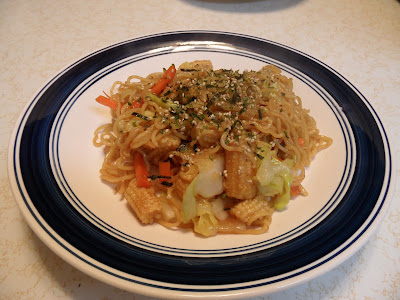Chinese food is delicious, there's no doubt about that. It's delicious, usually pretty cheap for the amount you get... but darn it, sometimes the restaurants just work odd hours and you need your lo mein fix ASAP. Well, I'm here to help! This staple dish and co-chief Chinese food carbohydrate (lest we forget fried rice... but that'll be an
I Can Cooking! for another time) is a lot easier to make than you might think... and quite possibly faster than delivery too.
 |
| Lo mein, the ultimate Chinese comfort food. |
What you'll need:
- Noodles: Any noodles will do; I use Myojo's ready-to-use yakisoba noodles since they're convenient (they're pre-cooked and come in a vacuum-sealed pack, if your grocer's has a cold-case with Asian foods, they're pretty much guaranteed to be in there). You can use ramen as well, you'll just have to pre-cook them until they're just about done.
- Vegetables: Cabbage, onion, and carrot are pretty much the "required" veggies for this dish, though you can add pretty much whatever others you want. I like mine with baby corn and bamboo shoots (though didn't have any on-hand when I made this batch, oh well).
- Oil: This one's actually pretty important. Since the noodles will soak up a decent bit of the oil, you'll want one that tastes good. A decent-quality olive oil does quite nicely; sunflower and sesame oils also make a pretty great result.
- Sauce: For this, simple soy sauce won't cut it. You'll want a thicker sauce like Hoisin, Szechuan, or other stir-fry sauces that'll actually stick to and soak into the noodles in spite of the oil. Teriyaki will also work, but you'll want the glaze kind rather than the sauce kind.
- Other Stuff: Though the recipe shown here is a vegetarian version of the dish, you can always add whatever meat you want to it. Shrimp is particularly awesome in this. The only difference in preparation is just that you'll need to make sure the meat's fully cooked or close enough to it before starting on the vegetables.
 |
| Not exact things, but a guideline. |
Step one: the Vegetable Phase
First, chop up the vegetables. For the carrots, you'll want to cut them into segments around 1-2inches, then split these into pieces around 1/4-in thick. This'll allow them to cook well, while retaining their character.
 |
| I think I saw something similar to this picture in a modern art museum. |
Put all the vegetables except for the cabbage into a wok or skillet with some oil, and let them sizzle for a bit.
 |
| Totally not a wok. OH WELL! |
While the other veggies are going, work on your cabbage. Chop the cabbage head in half, removing the "heart," then halve it again and chop into ~1/2-in pieces.
 |
| This looks like a lot now, but it'll cook down to like nothing. |
Once the onions begin to show a bit of translucency, add the cabbage along with a splash more oil. If you're like me and don't have a wok readily available, you may have to switch to a bigger vessel to fit all the cabbage. It reduces down a lot, but for now you'll need the room. Keep simmering the veggies, stirring frequently.
 |
| Totally not a wok either. |
Step 2: the Noodle Phase
Once the cabbage reduces down, add your noodles. If you're using the pre-cooked kind like I did, cover the pot for a few minutes so the steam will loosen up the noodles. If you boiled up some ramen (remember, go until they're ALMOST, but not quite, done), simply drain those noodles (leave out the seasoning packet) and put them in the pot with a bit of oil; skip to the next step.
 |
| Blocks of noodly goodness! |
With the noodles nice and wiggly, stir-fry them with the vegetables for a few minutes, being careful not to let them stick to the pot.
 |
| Told you the cabbage would reduce down! |
Once the noodles are soft but not sticky (meaning the oil's doing it's job), and have reached the degree of chewiness you want, add your sauce. For the amount of noodles I made here (3 packs' worth), around 1/2-cup of sauce should be sufficient, though you can add or subtract to taste. Stir the sauce in and let it cook for just a bit longer until it's been absorbed by the noodles.
 |
| Like spaghetti, but BETTER. |
Aaaaaand, done!
You've now made a lo mein that will rival even the best of delivery places, and put into it exactly what you want in it. Eat it by itself, or if you're feeling fancy, top it with some
furikake and/or mayo.
 |
| Now I just need to learn how to make fortune cookies. |
Enjoy!










No comments:
Post a Comment